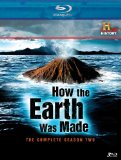“Earth: a unique planet. Restless and dynamic. Continents shift and clash. Volcanoes erupt. Glaciers grow and recede. Titanic forces that are constantly at work, leaving a trail of geological mysteries behind.”
I saw a bumper sticker recently that read; “Geologists dig classic rock”. I should have taken it as an omen that I would be spending some quality time with a few geologists over these last couple of weeks. It started with the excellent BBC mini-series How The Earth Changed History and culminated with the 13 episodes of the second season of How The Earth Was Made. It might be easy to confuse these titles in your video store. But, make no mistake about it. They are very different shows down to their core, pun intended.
Each episode of this History series focuses on a unique place or aspect of the Earth’s geology. Many of the shows deal with specific places, most of these American. Here you’ll find episodes on such American wonders as Yosemane National Park, The Grand Canyon, Mount St. Helens, and Death Valley. The typical formula here is we are introduced to the area of interest as it looks today. Soon we’re introduced to scientists, most of them employees of the United States Geological Society. They guide us to specific places in the target zone where they point out some of the more interesting rocks that have been discovered there. Through some CG animation we’re given some demonstrations that illuminate the popular theories on how the place got to be what it is today. There are some Mr. Wizard style experiments from time to time in an effort to demonstrate certain principles. The most interesting of these is certainly the Mount St. Helens episode which includes plenty of footage of the 1980 eruption, the very first recorded side-ways eruption of a volcano. In fact, this show is apparently obsessed with volcanoes. Each of the four discs contains a volcano related episode. Of particular interest to me was an incredible look at Italy’s Vesuvius. It’s amazing when you see the petrified remains of the people caught in its famous eruption. The show also appears to believe Naples is in eminent danger of a future eruption killing millions of people.
Then there are the generic episodes which deal with particular time periods. Examples of this kind of episode are How The Earth Was Born and The American Ice Age. In these episodes the formula takes more of the shape of a specific story. There’s a chronology used here that deals with more of the CG animation. Theories and the field evidence is presented.
The final episode of the season explores gold and how it was formed and eventually discovered.
Much of this stuff is theory, of course. To build some kind of suspense or interest the show plays a little like a detective story. Several times during each episode the series displays a series of “snapshots” and provides a summary of the “evidence” to that point. There are a lot of interesting facts to be sure. One of the most significant was that 90% of all earthquakes and 75% of all volcanoes are found on the Pacific Rim. From South America up through California across Alaska and the Pacific Coast of Asia most of the Earth’s distemper is exhibited. It’s quite a sobering thought, indeed.
Video
Each episode is presented in an annoying non-anamorphic 1.78:1 aspect ratio. You’d think we were beyond the non-anamorphic presentations. Frankly, it doesn’t even make economic sense. This is strictly standard documentary image here. It doesn’t have the benefit of a BBC high definition crew. There’s nothing particularly wrong with the image. It’s just that it comes from the field under field conditions and is intended to be nothing more than utilitarian.
Audio
The Dolby Digital 2.0 dialog is merely that, dialog.
Special Features
Nothing
Final Thoughts:
I’ll take Geology for 800, please Alex. If you’re thinking about making a run on Jeopardy this is the kind of stuff you need to know. A lot of it is as dry as The Sahara Desert, where they provide a completely different theory on how it was formed than the BBC show provided. It goes to show just how theoretical this all is, in spite of the show’s attempt to appear as though it’s nailing these things down definitively. Still, even with the dry moments I’ll admit that there is a tremendous educational value here. They do go deep into the heart of the matter, in a manor of speaking. There’s a lot to take in. While I don’t buy any of these theories 100%, there is enough here to say categorically that we live on an “ever-changing planet”.





